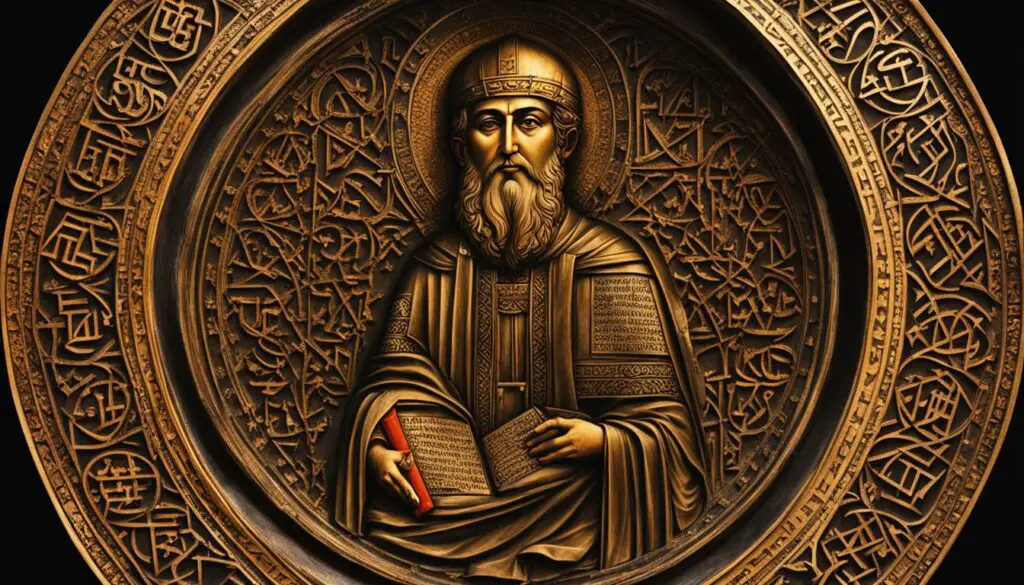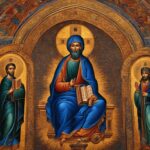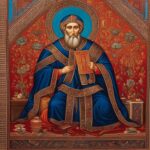St. Mesrop Mashtots, a saint revered for his profound impact on Armenian culture and history, is celebrated as the inventor of the Armenian alphabet. Born in Hatsik, Armenia in 360, he played a pivotal role in strengthening Armenian national identity through the development of the alphabet. With his visionary work, St. Mesrop Mashtots ensured the preservation of the Armenian language and opened the doors to a rich literary tradition.
After receiving a comprehensive education and becoming skilled in the Greek and Persian languages, St. Mesrop Mashtots felt a calling to religious life. He renounced his position as a secretary to King Khosrov IV and devoted himself to a life of austerity in a monastery. Embarking on a proselytizing mission, he spread the Gospel and converted many in the district of Goghtn near the river Araxes.
St. Mesrop Mashtots’ most significant contribution was the invention of the Armenian alphabet. He established numerous schools throughout Armenia to teach the new alphabet to the youth, personally teaching at the Amaras monastery in the Armenian province of Artsakh. His influence extended beyond Armenia, as he obtained permission to preach and teach in Constantinople. To ensure a robust literary tradition, he sent his disciples to study the Greek language and bring back Greek literary works.
Leading a deeply spiritual life, St. Mesrop Mashtots founded monasteries, composed hymns and liturgical music, and embraced the teachings of the Armenian Apostolic Church. His religious beliefs profoundly influenced his approach to the development of the Armenian alphabet and the preservation of Armenian language and literature.
Despite facing challenges and criticisms, St. Mesrop Mashtots dedicated his life to the establishment and preservation of Armenian cultural heritage. He actively worked to solidify Christianity in Armenia and suppress Mazdaism, a religion descended from Zoroastrianism. His translations of the Bible faced criticism, driving him to acquire authentic copies of the Greek text.
St. Mesrop Mashtots’ contributions have not gone unnoticed. He is venerated as a saint in various branches of the Christian faith and celebrated as the patron saint of Armenia. His name is read in the canon of the Liturgy, and his feast day is honored on February 17 in the Roman Catholic Church.
St. Mesrop Mashtots’ legacy lives on, with the Armenian alphabet serving as a testament to his enduring influence. His work laid the foundation for a rich national literature and strengthened the religious and cultural identity of the Armenian people. Today, his contributions continue to shape the vibrant Armenian culture, language, and heritage.
Key Takeaways:
- St. Mesrop Mashtots is revered as the creator of the Armenian alphabet, a monumental contribution to Armenian culture and history.
- His early life and comprehensive education prepared him for his future role in strengthening Armenian society.
- Feeling a religious calling, he renounced his position and embarked on a proselytizing mission, spreading the Gospel in Goghtn.
- St. Mesrop Mashtots’ most significant work was the invention of the Armenian alphabet and founding schools to teach it.
- He led a deeply spiritual life and his religious beliefs influenced the preservation of Armenian language and literature.
Early Life and Background
In 360, St. Mesrop Mashtots was born into a noble family in the town of Hatsik, located in present-day Armenia. His upbringing in a privileged environment provided him with a solid foundation for his future endeavors.
St. Mesrop Mashtots received a comprehensive education, which included the study of Greek and Persian languages. His proficiency in these languages played a pivotal role in his later contributions to Armenian society and culture.

The Noble Family of Hatsik
“St. Mesrop Mashtots hailed from a noble family in Hatsik, Armenia, known for their deep commitment to education and intellectual pursuits. It was within this cultural milieu that his desire to make a lasting impact on Armenian society and language took root.”
His early life and education laid the groundwork for St. Mesrop Mashtots’ future achievements, setting him on a path that would eventually lead to the creation of the Armenian alphabet.
Call to Religious Life
After serving as a secretary to King Khosrov IV and witnessing the challenges faced by his people, St. Mesrop Mashtots felt a profound religious calling. He renounced his position and, along with a few companions, chose to embrace a life of austerity within the walls of a monastery.
Driven by his faith and desire to spread the teachings of the Gospel, St. Mesrop embarked on a proselytizing mission. His dedication and fervor led him to the district of Goghtn, nestled near the majestic river Araxes.
Amidst the rugged landscapes, St. Mesrop fervently shared the message of Christianity, converting many to the faith. His eloquence, empathy, and unwavering commitment inspired others to join his cause, further expanding the reach of his religious mission.

Through his acts of devotion and his unwavering commitment to spreading the Gospel, St. Mesrop Mashtots exemplified the true essence of a religious calling. His selflessness and dedication continue to inspire believers across generations, serving as a guiding light in their own spiritual journeys.
Work
St. Mesrop Mashtots’ most significant contribution was the invention of the Armenian alphabet. He recognized the need for a written form of the Armenian language and embarked on a mission to create a unique alphabet to represent the rich sounds and complexities of the language.
To ensure widespread literacy and the preservation of Armenian culture, St. Mesrop Mashtots established numerous schools throughout Armenia. These schools taught the newly created Armenian alphabet to the youth, empowering them with the tools to communicate and celebrate their Armenian identity.
One notable institution where St. Mesrop Mashtots personally taught was the Amaras monastery in the Armenian province of Artsakh. Here, he inspired and educated future generations, leaving a lasting impact on the development of the Armenian alphabet and the preservation of Armenian culture.
St. Mesrop Mashtots’ influence extended beyond the borders of Armenia. He obtained permission from Emperor Theodosius the Younger to preach and teach in Constantinople, the capital of the Byzantine Empire. This allowed him to spread knowledge of the Armenian alphabet and language to a wider audience.
In his pursuit of knowledge and literary enrichment, St. Mesrop Mashtots sent his disciples to various centers of learning to study the Greek language and bring back Greek literary works. This exchange of knowledge played a crucial role in the development of Armenian literature and the enrichment of Armenian culture.

Schools Established by St. Mesrop Mashtots
| School | Location |
|---|---|
| Hromkla School | Near the city of Ani, present-day Turkey |
| Dwin School | Near the city of Van, present-day Turkey |
| Bagavan School | Near the city of Dvin, present-day Armenia |
| Pachar School | Near the city of Echmiadzin, present-day Armenia |
Boldly stepping into uncharted territory, St. Mesrop Mashtots’ work in creating the Armenian alphabet and establishing schools paved the way for the preservation of Armenian language, literature, and cultural heritage. His contributions resonate to this day, serving as a testament to the power of education and the enduring legacy of a visionary.
Spiritual Life and Philosophy
St. Mesrop Mashtots, the revered creator of the Armenian alphabet, led a deeply spiritual life dedicated to the teachings of the Armenian Apostolic Church. His profound religious beliefs shaped his approach to the development of the alphabet and the preservation of Armenian language and literature.
Embracing asceticism, St. Mesrop Mashtots founded monasteries as centers of spiritual devotion and learning. In these monastic communities, he fostered an environment of reverence, discipline, and contemplation, nurturing the spiritual growth of his fellow monks.

St. Mesrop Mashtots’ spiritual influence extended beyond monastery walls. Through his liturgical compositions and hymns, he sought to elevate the collective consciousness of the Armenian people, inspiring them to connect with the divine through music and prayer. His hymns and liturgical music continue to be cherished and sung in Armenian churches to this day.
“Music has the power to transcend earthly limitations and carry our souls closer to God.” – St. Mesrop Mashtots
St. Mesrop Mashtots’ spiritual calling influenced the development of the Armenian alphabet. He believed that language and literature were sacred vessels that could convey divine truths and preserve the spiritual legacy of the Armenian people. His work laid the foundation for a rich national literature, enabling the Armenian language to flourish and serving as a cornerstone of Armenian cultural heritage.
Connection between Spiritual Life and Language Preservation
St. Mesrop Mashtots understood the profound connection between spirituality and language preservation. In his belief, the preservation of the Armenian language ensured the continuity of the Armenian people’s cultural and religious identity. By inventing the Armenian alphabet, he empowered future generations to express their spirituality, convey their beliefs, and engage with their rich religious traditions.
| Key Contributions | Impact |
|---|---|
| Founded monasteries | Provided centers for spiritual devotion and preservation of religious traditions |
| Composed hymns and liturgical music | Elevated spiritual experiences and connected the Armenian people to their faith |
| Development of the Armenian alphabet | Laid the foundation for a rich national literature and cultural preservation |
Challenges and Criticisms
Throughout his life, St. Mesrop Mashtots faced various challenges and criticisms as he dedicated himself to the cultural and spiritual development of the Armenian people. His unwavering commitment to his beliefs and the advancement of Christianity in Armenia brought him into conflict with Mazdaism, a religion descended from Zoroastrianism.
As an advocate for Christianity, St. Mesrop Mashtots actively worked to suppress Mazdaism and promote the Christian faith. He believed that solidifying Christianity in Armenia was crucial for the cultural and religious identity of his people. His efforts to establish Christianity as the dominant religion faced opposition and criticism from those who adhered to Mazdaism.
“The teachings of Mazdaism and Christianity clashed in many ways, and St. Mesrop Mashtots firmly believed that the Armenian people deserved to be guided by the principles of Christianity, which he saw as aligned with their cultural heritage.”
Another area of criticism directed towards St. Mesrop Mashtots was his translations of the Bible. While his work was commendable, it faced scrutiny for its perceived imperfections. In response, St. Mesrop Mashtots sent disciples to obtain authentic copies of the Greek text, ensuring that the translations would be as accurate as possible.
Furthermore, some critics questioned the accuracy and suitability of the Armenian alphabet for representing the complex sounds of the Armenian language. This challenge pushed St. Mesrop Mashtots to refine the alphabet and develop additional characters to accurately depict the phonetics of the language.

Despite the challenges and criticisms he faced, St. Mesrop Mashtots remained steadfast in his dedication to his mission. His unwavering belief in the importance of Christianity, the accuracy of translations, and the refinement of the Armenian alphabet contributed to the enduring legacy of his work.
Recognition and Awards
St. Mesrop Mashtots is widely venerated as a saint in several branches of the Christian faith, including the Armenian Apostolic Church, the Armenian Catholic Church, the Eastern Orthodox Church, and the Roman Catholic Church. His remarkable contributions to the development of the Armenian alphabet and his dedication to preserving Armenian language and culture have earned him immense respect and recognition.
In the Roman Catholic Church, St. Mesrop Mashtots is celebrated on February 17th as his feast day. This day is an occasion to honor his life, legacy, and the transformative impact he had on the Armenian people. As the patron saint of Armenia, he serves as a symbol of national pride and devotion.
| Church | Feast Day | Patronage |
|---|---|---|
| Armenian Apostolic Church | No specific feast day | Patron saint of Armenia |
| Armenian Catholic Church | No specific feast day | Patron saint of Armenia |
| Eastern Orthodox Church | No specific feast day | Patron saint of Armenia |
| Roman Catholic Church | February 17 | Patron saint of Armenia |
Miracles and Path to Sainthood
Throughout his life, St. Mesrop Mashtots was revered as a holy figure, believed to have performed miraculous acts both during his time on earth and after his passing. His devoutness and unwavering faith in God made him a spiritual beacon for the Armenian people.
St. Mesrop Mashtots embarked on pilgrimages to the regions he had evangelized, spreading the teachings of the Armenian Apostolic Church. These pilgrimages served as a testament to his deep connection to his faith and his unwavering commitment to its preservation. He also played a vital role in the spiritual administration of the patriarchate, taking on the responsibilities left by his mentor, Isaac, after his death.
Today, St. Mesrop Mashtots’ name is revered and held in high regard within the Armenian Apostolic Church. His name is read in the canon of the Liturgy, symbolizing his spiritual legacy and ongoing influence on the Armenian people. His path to sainthood is marked by his dedication to God, his immense contributions to the Armenian culture and language, and the miracles attributed to him.
| Miracles | Description |
|---|---|
| Healing the sick | St. Mesrop Mashtots was said to have the ability to heal those suffering from various ailments, bringing comfort and relief to many. |
| Turning water into wine | Similar to the biblical account, it is believed that St. Mesrop Mashtots performed the miracle of turning water into wine, a symbol of abundance and celebration. |
| Resurrection of the dead | There are tales of St. Mesrop Mashtots bringing the deceased back to life, demonstrating his divine connection and his ability to transcend mortal limitations. |
| Protection from harm | Many individuals claimed to have experienced divine protection and intervention when seeking the intercession of St. Mesrop Mashtots. |
The miracles attributed to St. Mesrop Mashtots serve as a testament to his spiritual power and his status as a revered saint within the Armenian culture. His influence continues to guide and inspire the faithful, embodying the enduring legacy of his faith and the impact of his miraculous acts.
Legacy and Continuing Influence
St. Mesrop Mashtots, revered as the creator of the Armenian alphabet, has left behind a lasting legacy of immense cultural and historical significance. His pioneering work in the preservation of Armenian language, literature, and cultural heritage has laid the foundation for the vibrant Armenian identity that thrives today. Despite facing external pressures and challenges, St. Mesrop Mashtots’ influence endures, shaping the Armenian culture, language, and heritage.
The creation of the Armenian alphabet by St. Mesrop Mashtots was a monumental achievement that ensured the preservation of Armenian language and literature. By providing the Armenian people with a distinct written form, he empowered them to express their thoughts, emotions, and experiences in their own language. This linguistic autonomy played a crucial role in preserving the Armenian heritage and cultural identity.
Furthermore, St. Mesrop Mashtots’ work strengthened the development of Armenian national identity. In a time of political and social changes, the Armenian alphabet served as a unifying force, connecting Armenians across different regions and encouraging a sense of collective belonging. The ability to communicate and share ideas in their own language fostered a shared cultural consciousness and strengthened the bonds of the Armenian community.
Despite the challenges faced, St. Mesrop Mashtots’ influence can still be seen in the deep-rooted Armenian culture. The Armenian language, with its unique alphabet, continues to play a central role in everyday life, literature, music, and art. The rich and diverse Armenian heritage is celebrated and preserved through cultural institutions, festivals, and a thriving artistic community.
St. Mesrop Mashtots’ legacy goes beyond language and culture. His devotion to religious life and the Armenian Apostolic Church has shaped the spiritual life of the Armenian people. The impact of his work in monastic traditions, liturgy, and the composition of hymns can still be felt in modern Armenian religious practices. He has served as an inspiration and a guiding light for the spiritual and cultural consciousness of the Armenian community.
In conclusion, St. Mesrop Mashtots’ lasting legacy as the creator of the Armenian alphabet is a testament to his profound impact on Armenian heritage, cultural preservation, language preservation, and national identity. His work has not only ensured the survival of the Armenian language and cultural traditions but also continues to inspire future generations to embrace their roots and preserve their unique identity.
Conclusion
St. Mesrop Mashtots, the revered saint and creator of the Armenian alphabet, has left an indelible mark on Armenian history, culture, and national identity. His invention of the alphabet was not just a linguistic achievement but a profound contribution to Armenian cultural heritage. It served as a powerful tool for preserving the Armenian language and fostering a deep sense of national identity.
St. Mesrop Mashtots’ work went beyond the practicality of a written language. His spiritual legacy and dedication to his faith continue to inspire and guide generations of Armenians. Through his profound religious beliefs and his commitment to the Armenian Apostolic Church, he was able to instill a sense of spirituality and pride in the Armenian people.
Today, St. Mesrop Mashtots is regarded as a symbol of cultural heritage and the enduring spirit of the Armenian people. His influence extends far beyond his lifetime, as his work laid the foundation for the development of a rich literary tradition and the continued preservation of Armenian language and culture. The impact of his invention resonates deeply within the hearts of Armenians, serving as a reminder of their ancestral roots and inspiring a strong national identity.
FAQ
Who was St. Mesrop Mashtots?
St. Mesrop Mashtots was a renowned monk, theologian, linguist, and composer who is revered as the creator of the Armenian alphabet and played a pivotal role in strengthening Armenian national identity.
When and where was St. Mesrop Mashtots born?
St. Mesrop Mashtots was born in 360 in Hatsik, Armenia (now modern-day Mus, Turkey).
What was St. Mesrop Mashtots’ upbringing?
St. Mesrop Mashtots was born into a noble family in Armenia and received a comprehensive education, becoming skilled in both the Greek and Persian languages.
What led St. Mesrop Mashtots to religious life?
After serving as a secretary to King Khosrov IV and witnessing the challenges faced by his people, St. Mesrop Mashtots felt a calling to religious life. He renounced his position and devoted himself to a life of austerity in a monastery.
What was St. Mesrop Mashtots’ most significant contribution?
St. Mesrop Mashtots’ most significant contribution was the invention of the Armenian alphabet. He established numerous schools throughout Armenia to teach the new alphabet to the youth.
Where did St. Mesrop Mashtots teach the new alphabet?
St. Mesrop Mashtots personally taught at the Amaras monastery in the Armenian province of Artsakh.
Did St. Mesrop Mashtots face any challenges or criticisms?
Yes, St. Mesrop Mashtots faced challenges and criticisms throughout his life. He actively worked to suppress Mazdaism and faced criticism for imperfections in his translations of the Bible.
How is St. Mesrop Mashtots recognized and revered?
St. Mesrop Mashtots is venerated as a saint in the Armenian Apostolic Church, the Armenian Catholic Church, the Eastern Orthodox Church, and the Roman Catholic Church. His feast day is celebrated on February 17 in the Roman Catholic Church.
Did St. Mesrop Mashtots perform miracles?
St. Mesrop Mashtots was believed to have performed miracles both during his lifetime and after his death. He embarked on pilgrimages to the regions he had evangelized and oversaw the spiritual administration of the patriarchate.
What is St. Mesrop Mashtots’ legacy?
St. Mesrop Mashtots’ legacy is one of immense cultural and historical significance. Through the creation of the Armenian alphabet, he ensured the preservation of the Armenian language, literature, and cultural heritage.
















